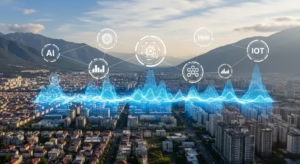AI in Earthquake Prediction: Can Algorithms Save Lives Before Disaster Strikes?

The blog post explores the intriguing field of AI earthquake prediction, emphasizing its potential to save lives by improving disaster responses. It highlights the significance of understanding AI earthquake prediction and how seismic data analysis plays a crucial role in identifying patterns that precede seismic events. Furthermore, the article examines innovative early warning systems powered by AI, demonstrating how machine learning algorithms can process vast amounts of data to generate timely alerts. Finally, the post discusses the importance of embracing geoscience AI for future earthquake preparedness underscoring the tech’s ability to enhance predictive models and support proactive measures. Overall, the integration of AI into earthquake prediction represents a promising advancement in our ability to anticipate and mitigate the impacts of these natural disasters.
Understanding AI Earthquake Prediction And Its Significance

AI earthquake prediction represents a groundbreaking advancement in natural disaster tech, promising enhanced accuracy and reliability in forecasting seismic events. By leveraging algorithms and vast datasets scientists can analyze patterns that may precede earthquakes allowing for timely alerts and potentially saving lives. The significance of this innovation cannot be overstated, as traditional methods of predicting earthquakes have been limited by their reliance on geological data alone. The integration of AI into this realm not only improves prediction models but also facilitates a proactive approach to disaster preparedness.
Key Benefits of AI in Earthquake Prediction
- Enhanced Prediction Accuracy: AI improves the precision of earthquake forecasting through sophisticated data analysis.
- Real-Time Monitoring: Continuous analysis of seismic data enables immediate adjustments in predictions.
- Risk Assessment: AI models help identify high-risk areas allowing for better resource allocation.
- Early Warning Systems: Automated alerts can be sent to communities at risk, reducing response times.
- Data Integration: AI can assimilate data from various sources leading to a comprehensive understanding of seismic activities.
- Cost Efficiency: Utilizing AI technology can reduce long-term costs associated with disaster preparedness and recovery efforts.
- Public Awareness: AI-driven insights can enhance public education regarding earthquake preparedness.
As we delve deeper into AI earthquake prediction, the transformative impact of this technology becomes evident. By harnessing machine learning and data analytics we can expect improved methodologies that not only enhance prediction capabilities but also prepare societies for potential disasters. The future of AI in this domain holds the promise of a world better equipped to deal with the unpredictable challenges posed by earthquakes forever changing the landscape of natural disaster tech.
The Role of Seismic Data Analysis in Earthquake Prediction

Seismic data analysis is crucial in the quest for reliable earthquake prediction. As scientists work to unlock the secrets of tectonic movements it becomes increasingly clear that understanding seismic waves is imperative. AI earthquake prediction systems utilize advanced techniques to analyze seismic data, enabling researchers to recognize patterns that may indicate impending seismic events. By leveraging these insights emergency preparedness can be improved, potentially saving countless lives in disaster-prone regions.
| Data Type | Collection Method | Usage |
|---|---|---|
| Seismic Waves | Ground-based sensors | Identify tremors and shocks |
| Ground Deformations | GPS and satellite imagery | Monitor tectonic plate movements |
| Historical Data | Seismic catalogs | Assess long-term seismic trends |
| Real-time Data | Seismic networks | Immediate analysis during events |
Understanding the nuances of the seismic data collected lays the foundation of predictive models. The process involves several crucial steps that allow scientists and engineers to derive meaningful conclusions from vast amounts of information. Geoscience AI has revolutionized this process enabling more efficient data processing and interpretation, which can significantly enhance prediction capabilities.
Steps in Seismic Data Analysis
- Data Collection: Gathering seismic data from various sources.
- Preprocessing: Filtering and cleaning the data for accuracy.
- Feature Extraction: Identifying key characteristics of the data.
- Modeling: Using AI algorithms to create predictive models.
- Validation: Testing models against historical seismic events.
- Implementation: Utilizing findings for early warning systems.
- Continuous Monitoring: Ongoing analysis to improve prediction accuracy.
AI Algorithms for Analysis
With advancements in technology, AI algorithms can process seismic data at unparalleled speeds. These algorithms analyze patterns that humans might overlook, offering improved predictive capabilities for earthquake occurrences. By incorporating machine learning and neural networks researchers can enhance their understanding of seismic behavior, leading to groundbreaking innovations in earthquake preparedness. The integration of seismic data analysis with AI holds the potential to transform our response to seismic threats making timely interventions more feasible and effective.
Innovative Early Warning Systems Powered by AI

As the frequency and intensity of natural disasters escalate, the need for effective early warning systems becomes more urgent. The integration of AI in earthquake prediction stands out as a pivotal innovation, enabling systems to analyze seismic activity with unprecedented accuracy. These systems leverage vast amounts of data to predict earthquakes potentially giving communities crucial moments to prepare for impending disasters. By harnessing the power of machine learning and deep learning algorithms AI can identify patterns in seismic data that human analysts might overlook.
| System | Technology Used | Effectiveness |
|---|---|---|
| ShakeAlert | Machine Learning | Alerts within 10-20 seconds |
| Early Warning System (EWS) Japan | Seismic Networks | Alerts in under 15 seconds |
| QuakeAlert USA | Smartphone Apps | Alerts using location data |
| Early Warning Research (EWR) | AI Data Processing | Provides real-time monitoring |
AI-powered natural disaster tech is not just about prediction but also involves enhancing communication and response strategies. Community members receive real-time alerts through various platforms including mobile applications and automated call systems. This communication ensures that citizens are informed and can take immediate actions such as moving to safer areas or following emergency protocols. Moreover, collaboration with emergency services allows for a coordinated response to potential threats significantly mitigating the impact of earthquakes.
Features of Modern Early Warning Systems
- Real-time data analysis and processing
- Integration with local emergency services
- User-friendly mobile notifications
- Automated communication systems
- Historical data utilization for predictive analytics
- Geolocation-based alerts
- Machine learning adjustments to improve accuracy
AI not only aids in the immediate prediction of earthquakes but is also crucial in research endeavors aimed at understanding seismic patterns over time. A significant aspect of these innovations lies in comparative analyses of warning systems, which can provide valuable insights into their effectiveness and areas for improvement. As technology evolves so too must our strategies for disaster preparedness ensuring communities are equipped to handle potential crises efficiently.
Comparative Analysis of Warning Systems
Evaluating the performance of various early warning systems reveals distinctive features and effectiveness. For instance, the timeliness of alerts and the systems’ ability to process vast streams of data can vary greatly between countries and technologies. Analyzing historical data on earthquake occurrences complements AI’s predictive capabilities ultimately leading to enhanced responsiveness for first responders and governmental bodies. These improvements are critical as they can potentially save lives during catastrophic events proving the necessity of ongoing advancements in AI earthquake prediction.
Embracing Geoscience AI For Future Earthquake Preparedness
The integration of geoscience AI into earthquake prediction represents a revolutionary shift in how scientists approach natural disasters. This technology leverages vast amounts of seismic data to create models that not only interpret past earthquakes but also attempt to predict future events. With enhanced algorithms and machine learning techniques the potential for improving our understanding of earthquake patterns is unprecedented, providing communities with invaluable time to prepare and mitigate damage before disaster strikes. By embracing these innovations we can develop a more resilient infrastructure, ultimately saving lives and reducing economic losses.
Actionable Steps for Implementing AI Technology
- Invest in data collection infrastructure to gather comprehensive seismic data.
- Collaborate with leading experts in geoscience AI and machine learning.
- Develop a robust AI earthquake prediction model tailored to local geological conditions.
- Establish real-time data monitoring and analysis systems.
- Implement educational programs for emergency management teams on AI applications.
- Engage with the community to raise awareness about AI-driven earthquake preparedness.
- Continuously update and refine AI models based on new research and data.
Furthermore, the role of collaboration cannot be understated. As researchers policymakers and technology developers come together to foster innovation in AI earthquake prediction, they build a framework for effective communication and resource-sharing that enhances preparedness efforts. Such alliances are essential in ensuring that the developed solutions are not only technically sound but also relevant and useful for communities at risk. Ultimately, the proactive adoption of geoscience AI in this field lays the groundwork for a safer and more informed society in the face of seismic threats.
For similar articles, please visit: AI in Environment & Sustainability
Homepage / humanaifuture.com




